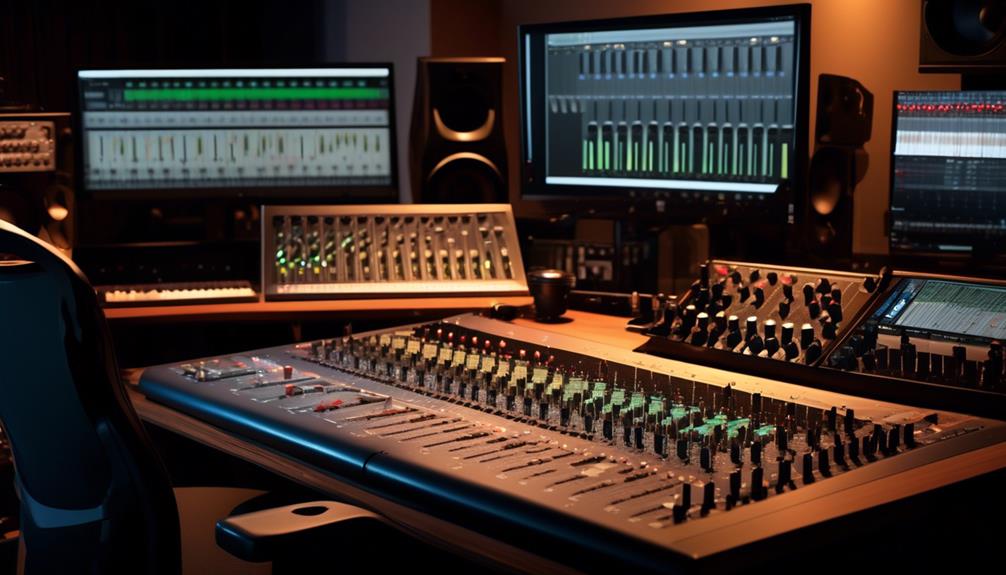No products in the cart.
Navigating the ocean of music production, you understand that crafting a melody is much like setting sail on a vast sea—it requires a blend of intuition, skill, and the right navigational tools.
As you embark on your journey, you’ll find that familiarizing yourself with your Digital Audio Workstation (DAW) is as crucial as a captain knowing their ship.
Remember, it’s important to take breaks to avoid the audio equivalent of scurvy—ear fatigue—which can skew your perception of the sounds you create.
You’ll learn that finishing tracks, rather than leaving them in the perpetual limbo of ‘work-in-progress’, is key to your development.
And while continuous learning and seeking improvement might often feel overwhelming, it’s the compass that keeps you on course. By trying new things, you’ll steer clear of the doldrums of a creative rut, maintaining a wind in your sails.
Striving for consistency and productivity will ensure your voyage is not led astray by the sirens of procrastination. Sometimes, the simplest route is the most effective, so simplifying your workflow can prevent unnecessary complications.
But know when the extra effort is the tide that lifts all boats, elevating your music to new heights.
As you stand at the helm, ready to chart a course through the swirling whirlpools of melody and harmony, ask yourself—are you prepared to uncover the secrets that lie beneath these sonic waves?
Key Takeaways
- Understanding music theory and composition is essential for creating compelling melodies and chord progressions in electronic music production.
- Selecting the right Digital Audio Workstation (DAW) is crucial, considering specific needs, user interface, features, and compatibility with existing hardware.
- Crafting memorable melodies involves studying popular melodies, experimenting with rhythms and note lengths, incorporating vocal hooks, and adding variation.
- Paying attention to space, dynamics, and dynamic range can enhance the impact and emotion of a track by using silence, strategic panning, and understanding how dynamic range shapes energy and mood.
Understanding Music Theory Basics
To lay a solid foundation in music production, you’ll need to grasp the essentials of scales, chords, and chord progressions that form the backbone of music theory. Understanding these concepts isn’t just about traditional composition; it’s crucial for applying music theory to electronic music. As you craft emotive melodies, recognizing scale degrees and the emotional color they impart can transform your soundscapes, giving them depth and feeling that resonate with listeners.
Incorporating music theory in hip hop production, for instance, involves more than laying down a catchy beat. It’s about weaving rhythm with theory to create grooves that are both complex and infectious. By exploring how syncopation and off-beat rhythms play against common chord progressions, you can innovate within the genre, pushing boundaries and setting new standards.
Delving into song structure and form, you’ll discover how to build dynamic arrangements that captivate your audience. Analyze your favorite tracks with a theoretician’s ear—break down their chord sequences, dissect their melodic choices, and scrutinize their rhythmic patterns. This analytical approach will unveil the architecture of successful songs, providing you with templates for innovation in your own music production journey.
Selecting the Right DAW
When diving into the vast world of music production, selecting a DAW that aligns with your creative workflow and technical demands is crucial for crafting your signature sound. You’ve got to consider your specific needs and how the DAW caters to them. It’s more than just preference—it’s about harnessing a tool that becomes an extension of your artistic vision.
Start by evaluating features—what does each DAW offer in terms of virtual instruments, effects, and mixing capabilities? Does the user interface encourage your creativity or stifle it with complexity? You’re looking for a seamless blend of power and usability.
Don’t just settle on the first DAW you encounter. Try out multiple options. It’s about how the software feels in action—how intuitively you can navigate its realms and translate ideas into audible reality.
Also, consider DAW compatibility with your existing hardware. You don’t want to face the frustration of gear conflicts after investing time and resources. And let’s not forget the importance of a supportive community and responsive customer support. These elements are vital, ensuring you stay updated and can troubleshoot any issues swiftly.
Select wisely, and let your chosen DAW be the bedrock on which you build your musical masterpieces.
Crafting Catchy Melodies

Understanding the anatomy of a catchy melody can elevate your music, ensuring your tunes resonate with listeners and stay with them long after the song has ended. Start by studying popular melodies within your genre, dissecting what hooks the ear. Is it a particular rhythmic pattern, a certain interval leap, or maybe a repetitive motif?
Exploring different melodies means diving into a variety of rhythms and note lengths. Don’t just stick to what’s familiar; play with off-beat accents or syncopation to add a unique flair to your melodies. The right chord progression can act as a backbone, giving your tune a solid structure to build upon.
Incorporating vocal hooks is a powerful tactic. These are the golden nuggets of your track—phrases that listeners can’t help but sing along to. Use repetition wisely; it’s the glue that makes your melody stick. But remember, variation is the spice. Introduce slight changes to keep the melody fresh and captivating.
Don’t underestimate simplicity. Often, a straightforward melody can be the most memorable. Consider the emotional pull of your tune. Should it uplift, soothe, or energize? Your melody’s emotional intent should align with your song’s overall vibe, creating a coherent musical experience that’s innovative and unforgettable.
Utilizing Space and Dynamics
You’ve mastered melodies, now let’s tackle the subtleties of silence—think of it as an instrument to punctuate your music with tension and release.
Don’t underestimate the power of dynamic range; it’s crucial for injecting your tracks with life and emotion, making them breathe.
Carefully consider the placement of each instrument in the stereo field, as strategic panning can add a compelling layer of depth and movement to your mix.
Embrace Silence as Instrument
Consider the profound silence between notes as a crucial component of your music, for it can elevate the emotional depth and dynamic contrast of your compositions. Silent pauses aren’t just absences of sound; they’re opportunities to create suspense and anticipation. Harnessing silence and tension within your melodies makes each note that follows more impactful.
| Element | Benefit | Technique |
|---|---|---|
| Silent Pauses | Enhances narrative expression | Intentional breaks in phrasing |
| Dynamics | Builds emotional intensity | Varied volume and articulation |
| Tension | Invokes listener’s expectation | Strategic use of rests and tempo |
| Space | Allows for musical “breathing” | Deliberate use of timing |
Master these aspects, and you’ll craft melodies that communicate more than notes alone ever could. Use silence innovatively—it’s as powerful as any instrument in your arsenal.
Dynamic Range Importance
While mastering silence sharpens your musical narrative, it’s equally critical to grasp how dynamic range can sculpt the energy and mood of your tracks. In film scoring, the dynamic range is pivotal; it carves out emotional highs and lows, guiding the audience through the story’s fabric. A well-executed dynamic range creates a sonic tapestry rich in depth and dimension, making each moment more poignant.
Beware though, the impact of compression on dynamic range can be a double-edged sword. Over-compression flattens these vital dynamics, squeezing the life out of your mix. Instead, use compression judiciously. Let the peaks soar and the troughs resonate. This approach ensures that every note and every silence holds weight, crafting a truly immersive auditory experience.
Strategic Instrument Placement
Harnessing the power of strategic instrument placement transforms a cluttered mix into a harmonious orchestra where each element distinctly resonates in its own acoustic territory. Instrument positioning isn’t just about left or right; it’s about sculpting sonic depth that captivates listeners.
By mastering panning and stereo imaging, you’re painting a three-dimensional soundscape, ensuring that the kick drum’s thump and the lead guitar’s wail aren’t jostling for the same sonic real estate.
Delve into the dynamics with finesse—adjust volume and intensity to imbue each track with life. Don’t shy away from using reverb and delay to etch out space, making a synth pad hover ethereally in the background or a snare snap sharply in the foreground.
Your mix can breathe, pulse, and move with innovative acuity.
Layering Sounds Effectively
To craft a sonically rich and clear mix, it’s crucial to master the art of layering sounds by meticulously understanding their frequency ranges and dynamic interactions. When you’re creating unique soundscapes, this skill becomes the backbone of your production.
Layering vocals effectively can transform a simple melody into a complex, emotive experience. Here’s how you can layer sounds with precision and creativity:
- Dissect Frequencies: Start by isolating the frequency range of each element. Use EQ to cut or boost frequencies, ensuring that each layer sits comfortably in the mix without muddying the overall sound.
- Combine with Purpose: Don’t just pile sounds on top of each other; select complementary textures and timbres to add depth. Think about how each layer interacts and contributes to the collective mood.
- Spatial Dynamics: Utilize panning and reverb to place sounds within a three-dimensional space. This separation gives each layer its own distinct location, preventing auditory confusion.
- Dynamic Textures: Pay attention to the attack, sustain, release, and decay of each sound. Tweaking these parameters helps to mesh layers together seamlessly, crafting a cohesive and dynamic soundscape.
Experimenting With Harmony


Dive into the world of harmony by experimenting with various chord progressions and voicings, which can infuse your music with a distinct character and emotional depth. As you craft your melodies, consider the transformative power of modal interchange progressions. This technique involves borrowing chords from parallel modes or scales, and when used judiciously, it can add unexpected colors to your harmonic palette.
Don’t be afraid to stray from conventional progressions. Borrowed chords exploration can lead to rich, nuanced soundscapes. For instance, substituting a major chord with its minor counterpart from a parallel key can elicit a poignant, bittersweet emotion. This kind of harmonic twist can catch your listener’s ear and convey complex feelings.
Integrate non-traditional elements like dissonance and extended chords for that cutting-edge vibe. These can create a sense of tension and release, essential for dynamic and engaging compositions. Pay attention to harmonic rhythm as well—varying the pace at which chords change can inject life into a static melody.
Structuring Your Arrangements
When crafting your music, start by outlining a clear structure to give your arrangement direction and purpose, ensuring every element works together to create a compelling narrative. A strong structure is the backbone of any great track, keeping listeners engaged from start to finish.
Here’s how you can structure your arrangements with innovation and technical precision:
- Envision Your Structure: Before touching your instruments, imagine the journey you want your listeners to take. Use structural templates like AABA or ABAB as a starting point, but don’t be afraid to break the mold to suit your track’s unique story.
- Dynamic Contrast: Keep your audience hooked by incorporating dynamic shifts throughout your piece. Loud and soft, dense and sparse—these contrasts add depth and intrigue to your music.
- Building Tension and Release: Master the art of suspense. Strategically place crescendos or introduce new elements to build tension, then provide the satisfying release that keeps listeners craving more.
- Smooth Transitions: Ensure your transitions between sections are seamless. Whether it’s a subtle change in instrumentation or a dramatic key shift, your transitions should guide the listener effortlessly through the sonic landscape you’ve created.
Polishing With Mixing Techniques


Once you’ve structured your arrangement, it’s time to focus on refining your sound with precise mixing techniques.
You’ll need to balance instrument levels meticulously, ensuring each element sits perfectly in the mix without overshadowing others.
Applying EQ strategically is crucial to carve out space for every frequency, achieving a clear and harmonious blend that defines your track’s character.
Balancing Instrument Levels
To achieve a polished mix, you’ll need to skillfully balance the levels of each instrument, ensuring they complement rather than compete with one another. Understanding the importance of instrument separation is crucial. Here are some techniques for achieving balanced instrument levels:
- Panning: Use it to place instruments in the stereo field, creating separation and space.
- Volume Automation: Apply it to adjust levels dynamically, adding life and movement to your mix.
- Frequency Range Consideration: Prevent masking by carefully tweaking the levels of instruments that share similar frequencies.
- Cross-referencing: Regularly switch between different speakers and headphones to ensure your mix translates well across various systems.
Master these techniques to craft a mix where every element sits perfectly in its own sonic niche.
Applying EQ Strategically
After mastering the balancing of instrument levels, you’ll find that applying EQ strategically is the next critical step in refining your mix to achieve a professional sound. Dive into the frequency spectrum with surgical precision, identifying and resolving problematic frequencies that can muddy your mix.
Carve out distinct sonic spaces for each instrument and vocal track using EQ techniques that ensure clarity and separation.
Employ high-pass and low-pass filters to eliminate extraneous frequencies, cleaning up your mix for a tighter, more focused sound. Enhance the definition of individual tracks by boosting or cutting specific frequency ranges, always with the goal of frequency management that elevates the overall mix.
Your creative EQ adjustments will ultimately bring out the best in every element, polishing your production to a gleaming finish.
Frequently Asked Questions
How Can I Get Better at Producing Music?
To improve at producing music, you’ll need to master your DAW and embrace creative experimentation. Push boundaries, blend genres, and refine your technical skills for innovative soundscapes that resonate with listeners.
How Can I Be Successful in Music Production?
To succeed in music production, you’ll need to dive into creative collaboration and embrace genre experimentation. Constantly hone your technical skills and stay ahead by innovating with every project you undertake.
What Makes Production Good on Music?
Good production hinges on masterful sound design and mixing techniques. You’ll create innovative sounds and achieve clarity, ensuring each element sits perfectly in the mix to captivate and immerse your listeners.
What Makes a Great Music Producer?
You’ll shine as a producer by adopting a producer mindset focused on innovation, mastering equipment essentials, and balancing technical expertise with creativity, always pushing boundaries for that fresh, detail-oriented sound.
Conclusion
You’ve got the tools now, so dive in and make those tracks shine. Remember, a solid grasp of theory underpins catchy melodies, while your DAW’s the canvas for your creativity.
Balance space with dynamics, layer sounds for depth, and play with harmony to keep things fresh. Structure’s your roadmap; don’t lose sight of it.
Finally, mix with precision—polish until it gleams. Stay dedicated, keep learning, and let your music speak volumes.
Now, go create your masterpiece.




